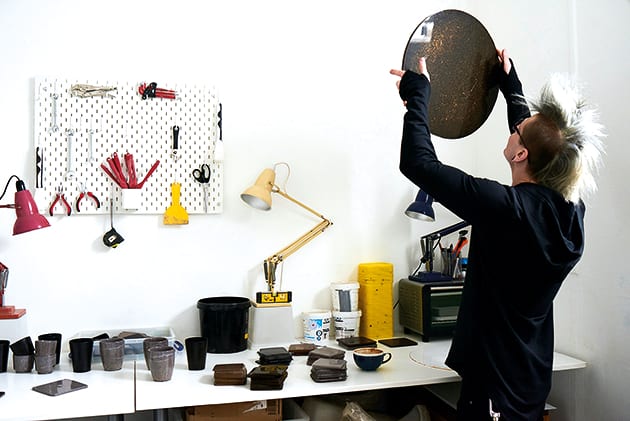 |||
|||
Most people don’t give a second thought to the waste created by their daily caffeine fix, but not industrial designer Atticus Durnell. He has cleverly harnessed coffee grounds to create a durable material that he has used to create a range of furniture and lighting. “I see it working as worktables and surfaces for kitchens, as well as bathrooms, due to its properties,” he says.
Experimentation started early for Durnell. “As a child I was always taking my toys apart, learning how things were put together,” he says. He is originally from a town in Poland called Głogów and, after spending time in Wrocław in the western part of the country after high school, he moved to the UK in 2011. He graduated from the University for Creative Arts in Rochester in 2018.
Dismayed that in the UK we generate more than half a million tonnes of coffee waste annually, Durnell was inspired to divert some of that from landfill by finding an alternative use. “I started experimenting with petrol-based resin [polyurethane resin] due to the low cost and to test out the idea,” he explains. “I then moved on to more sustainable solutions like biodegradable, plant-based resins and then experimenting on making my own one from scratch.”

Since graduating, he has focused on this sustainable material solution with a startup called That’s Caffeine – making products including a tabletop, stools and tiles – which has already received a Design Guild Mark in the 2D category. The process involves collecting the coffee waste from local businesses and then drying it.
“Next, when I’m working on the product, I’m mixing coffee grounds, minerals and resin mix with the substance, which will then be a catalyst in the process, solidifying it,” he explains, adding that the entire process is based “on a thermo and chemical reaction”. Depending on the size of the batch, it takes a day or two to set.
For the colours, which maintain a mostly neutral palette of white, grey and black, “I looked back in history to see how colours and dyes were made. I use things like graphite, mica powder and turmeric – most people are making curries with that but I’m making coffee tables,” he laughs. A floor lamp, also part of the collection, has additional parts made from a mix of foam and Jesmonite.

Durnell admires the work of Studio Swine, particularly its São Paulo collection inspired by the tropical modernism movement of mid-century Brazil. This project saw the duo scouring the place, also known as ‘aluminium city’, from which the range takes its name, to produce various pieces of furniture and lighting. Durnell is also inspired by Guangzhou-based Bentu Design, “I love their ethos and the results of their work, which is based on whatever they find surplus on the landfills. I admire seeing that kind of initiative in the middle of China, which is considered the main outlet of global waste. I would love to collaborate or work with them in the future if the opportunity arises.”
Exhibiting his work at trade shows has been key in advancing his business, Durnell says. “New Designers was where everything started,” he says of his 2018 appearance at the graduate event. Last year, he also won the Design Fresh award at 100% Design, a section of the show dedicated to breakthrough design talent, curated by the Evening Standard’s design editor Barbara Chandler.
Durnell is involved in 100% Design again this year in a number of ways. He is working on a new line of lighting products and is hoping to release some of those at the Emerging Brands section. He is also part of a talk at The Forum from 12.15-12.45pm on 18 September, titled Beyond Sustainability: The Future of Waste in Design. There he will be chairing a session with panellists Adam Davies, co-founder of Tŷ Syml; material designer Clemence Grouin-Rigaux and Johannes Kiniger, co-founder at High Society, looking at the impact of industry on raw materials shortages and the environment, asking how environmentally sustainable this model can ever be.

Durnell believes that designers really do hold a responsibility for the future of the planet and hopes his work and that of others will have a positive impact on energy consumption and waste reduction. When scouting the next big things as part of nominating designers for this year’s Design Fresh, he was looking to see if the current climate emergency has become a more mainstream part of the thinking of design’s next generation “or whether it’s still just a handful of forward-thinking designers that are in the sustainable minority”.
For his part, he says: “I’m working on something for Design Fresh to be revealed at the show. Last year it really was a huge help.” After that it’s a return to Poland to exhibit at a show called Warsaw Home, as part of its Ideas section, followed by an appearance in Eindhoven for Dutch Design Week at the Isola Design District section. And then there’s the not-insignificant matter of starting a master’s in biodesign at London’s Central St Martins. “My product design course was quite artistic and this is something scientific to enable me to continue to make strides in material innovation.”
As originally featured in the October 2019 LDF Issue of OnOffice (148)
Industrial designer Atticus Durnell turns waste coffee grounds into a durable material used for surfaces, containers and furniture. Ahead of an appearance at 100% Design, he explains how






















